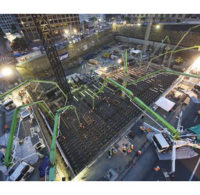Wilshire Grand Concrete Mat Placement Sets U.S. Record






"We poured between 1,200 yards and 1,500 yards each hour," says Michael Marchesano, general superintendent with Turner Construction Co.'s local office.
The operation demanded careful choreography between 208 concrete mixers—each making a dozen trips to and from one of eight Southern California batch plants—and 225 workers operating 19 concrete pumps. Bringing so many trucks downtown via the city's notoriously congested freeways required meticulous logistical planning, says Marchesano.
Workers tremied the nearly 41,000 tons of concrete into an intricate network of reinforcing steel at the bottom of the site's 106-ft-deep excavation. The nearly 18-ft-deep rebar cage weighs almost 3,500 tons and contains up to 13 layers of 2.5-in.-dia rebar, topped by multiple layers of smaller-diameter rebar. The curving foundation measures 266 ft long by 108 ft at its widest, with a total area of 32,474 sq ft.
U.S. Record-Setter
Guinness World Records' adjudicator Michael Empric was on hand to monitor the activity and present Wilshire Grand with the official Guinness nod. But there have been other continuous concrete efforts that were reportedly much larger, including the MesseTurm office tower in Frankfurt, Germany, in 1988, and Beijing's China Central Television building in 2005. But those projects were not monitored or verified by Guinness officials.
Wilshire Grand tops the previous U.S. record-holder, the Venetian Hotel in Las Vegas, which required a 21,000 cu yd placement in 1999.
Key engineering and constructibility issues outweighed the risks of placing such a large quantity of concrete for the 73-story Wilshire tower's foundation, says Chris Martin, CEO of both project architect AC Martin Partners and project manager Martin Project Management.
Located near a fault line, the site slopes from one corner to the other, leading to high horizontal loads. The tall and slender profile of the tower interacts with Santa Ana winds to create forces that are even more dynamic than the area's considerable seismic loads, Martin says.
Noise concerns ruled out pile-driving. "I don't think we had any other choice [but] to do this," Martin says.






